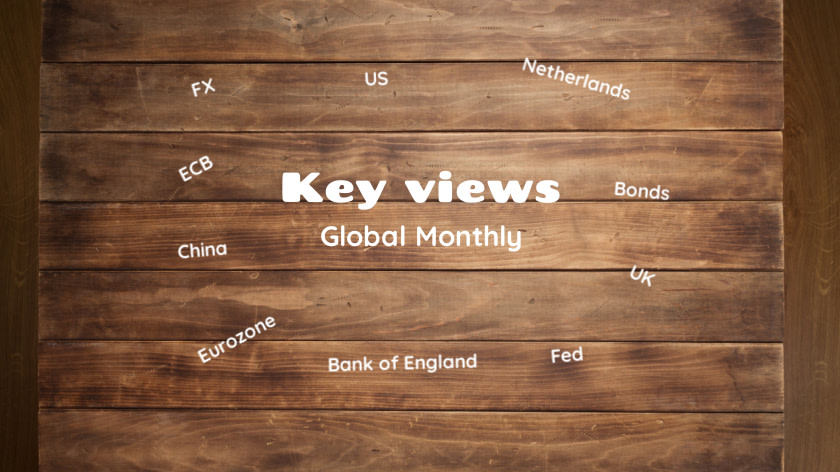Key views Global Monthly September 2025

Global growth is slowing, as the US tariff shock drives an unwind of the frontloading of exports that occurred in Q1. While the tariff hit to growth remains significant, the deals struck over the summer – to the extent that they stick – have limited the downside risks. Interest rate cuts and other forms of policy support are a cushioning factor in the eurozone and China, while in the eurozone specifically, defence spending, and in Germany new infrastructure spending will support growth in late 2025 and into 2026. Still, the nascent recoveries in domestic demand in the eurozone and China face downside risks from weaker confidence, while in the US, demand will be hit by the tariff impact on real incomes. Inflation in the US is expected to reaccelerate, but to fall below target in the eurozone. Still, the divergence in Fed & ECB policy will gradually narrow. After the September ‘insurance cut’, the Fed is expected to lower rates by 100bp in 2026, with the ECB expected to stay on hold.
Macro
Eurozone
Growth in the near term is slowing on the back of US tariffs and an unwind of US export frontloading, though the recovery in domestic demand (helped by past rate cuts) is a key offset. Next year, higher defence and German infrastructure spending are likely to drive higher quarterly growth. Disinflation is continuing, with services inflation falling more quickly than expected, and wage growth continuing to cool. Food prices bear close watching given their importance for expectations. Still, falling energy prices are likely to drive an undershoot of the 2% inflation target later this year, helped by a stronger euro.
The Netherlands
After budget day we are heading into election season with Dutch elections scheduled for 29th of October. The Dutch economy is resilient, with for instance a structurally tight labour market, but it faces lower growth in the near term, in part due to the effects of US tariffs. In 2026, growth is set to increase on the back of rising real incomes, fiscal measures, rate cuts feeding through and spillovers from the German fiscal expansion. Inflation, still significantly above 2%, is expected to ease further, but to stay elevated compared to the eurozone in the coming quarters.
UK
The economy is slowing on the back of the US tariff shock, as the frontloading of trade in H1 is unwound in H2. Still, the UK is less vulnerable to US tariffs than the eurozone, as it is less export dependent and faces a lower tariff rate. Lower interest rates and higher government spending are also giving some support to growth. Inflation remains stubbornly high, with wage growth still well above levels consistent with 2% inflation. The rise in food inflation is also a concern for inflation expectations, which have been historically high in the UK.
US
Tariffs and elevated uncertainty continue to slow down the economy. The impact of the Trump administration's policy will gradually build in the hard data. Despite an upgrade to our growth forecast, we still expect growth to slow down to 1.8% in 2025 and 1.5% in 2026. Tariffs will lead to an increase in PCE inflation to 3.1% by year end. Despite downward revisions in non-farm payrolls, deterioration in the labour market remain relatively contained as lower labour demand is paired with lower labour supply due to lower immigration. The unemployment rate only rises gradually to 4.5 by year end.
China
Whereas GDP growth in 1H25 was resilient during the trade war, thanks to export rerouting/diversification, July and August data point to a slowdown. Most striking is the drop in investment growth; the crackdown on excessive competition and the ongoing property slump are driving this. With annual GDP growth set to slow materially in 2H25, we expect more targeted stimulus and piecemeal monetary easing, but no bazooka. The Fed September cut creates room for manoeuvre, but the PBoC – with its multifaceted mandate – will likely remain cautious, also keeping an eye on the hot stock market.
Central Banks & Markets
ECB
The Governing Council kept policy on hold in September, and is likely to remain on hold for the foreseeable future. President Lagarde has said that the ECB is ‘well positioned’ to face the coming period of tariff impact and uncertainty. Despite the expected undershoot of the 2% inflation target, the GC seems minded to look through this on the expectation that inflation will return to target in 2027. Although the ECB’s inflation projections factor in one more 25bp rate cut (based on market rate expectations in June), we doubt the Governing Council is minded to fine-tune policy to that degree.
Fed
The Fed did a ‘risk management’ cut of 25 bps, putting rates in the 4.00-4.25% range, due to labour market and inflation risks coming closer to being balanced. In our base case, labour market data for the remainder of the year will come in relatively benign, while both goods and services inflation will pick up further. As a result, we expect the Fed to keep rates at their current level until next year. Come January, a more dovish rotation of voting regional Fed presidents will lead to a gradual lowering of the policy rate to the extent that inflation allows, at a pace of 25bps per quarter.
Bank of England
The MPC kept Bank Rate at 4.00% in September, in line with our expectations. Four of the nine MPC members dissented against the last rate cut in August, and Governor Bailey has cast doubt on the timing of future cuts. In light of this and given sticky inflation, we now expect the next rate cut to come next April. We then see one final cut in July, taking Bank Rate to 3.5%. If wage growth fails to normalise, and/or if inflation expectations stay elevated, the risk is for these cuts to be further delayed.
Bond yields
The ECB's rate-cutting cycle seems to have ended, leaving little scope for German 10y yields to fall further. We expect long-term yields to face upward pressure, driven by a rising term premium in Germany, reflecting higher government spending and increased debt supply in the coming years. Meanwhile, US 10y yields remain relatively low as markets price in substantial rate cuts. However, we believe the Federal Reserve will hold its current stance, prompting a significant market repricing to align with macroeconomic fundamentals.
FX
Last week, EUR/USD hit its highest level for the year at 1.1919, and the US dollar index was getting close to its lowest point of the year. After the Fed decision to lower rates the dollar recovered across the board. There are signs that the US dollar index is struggling to drop below 96 and EUR/USD is struggling to stay above 1.19. Our forecast for EUR/USD end 2025 stands at 1.15 and end 2026 stands at 1.25.
